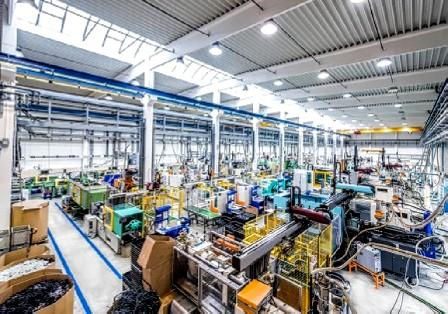Plastics Molding and Forming Effluent Guidelines
 EPA promulgated the Plastics Molding and Forming Effluent Guidelines and Standards (40 CFR Part 463) in 1984. The regulation covers direct dischargers
EPA promulgated the Plastics Molding and Forming Effluent Guidelines and Standards (40 CFR Part 463) in 1984. The regulation covers direct dischargers![]() direct dischargerA point source that discharges pollutants to waters of the United States, such as streams, lakes, or oceans.. The Effluent Guidelines and Standards are incorporated into NPDES permits.
direct dischargerA point source that discharges pollutants to waters of the United States, such as streams, lakes, or oceans.. The Effluent Guidelines and Standards are incorporated into NPDES permits.
- What is the Plastics Molding and Forming Industry?
- Related Categories
- Rulemaking History
- Additional Information
What is the Plastics Molding and Forming Industry?
The plastics molding and forming (PM&F) industry is a large and diversified industry that uses plastic materials to produce a wide variety of consumer and industrial products. The product markets include automobiles, appliances and electronics, construction materials, disposables, household furnishings, housewares, and medical products.
There are many different types of production processes that process various combinations of raw materials. PM&F plants blend, mold, form, or otherwise process plastic materials into intermediate or final plastic products. They include commonly recognized processes such as extrusion, molding, coating and laminating, thermoforming, calendering, casting, foaming, cleaning, and finishing.
Process water is used in PM&F plants to cool or heat the plastic products; to clean the surfaces of both the plastic products and the equipment used to produce those products; and to finish plastic products.
At the time of the 1984 rulemaking there were approximately 10,260 PM&F facilities in the United States, of which 810 were direct dischargers. (There were also 1,145 indirect dischargers, which are subject to the General Pretreatment Regulation at 40 CFR Part 403.)
PM&F activities are included within NAICS group 3261, Plastics Product Manufacturing.
(Note: the NAICS listing is provided as a guide and does not define the coverage of the PM&F category. For precise definitions of coverage, see the applicability sections in 40 CFR Part 463.)
Wastestreams
The PM&F regulation covers process wastewater. Non-contact cooling water (water that does not contact either the plastic product or equipment surfaces that have contacted the plastic product) is not covered by the regulation, but may be addressed in individual permits on a case-by-case basis.
- wastewater generated during the reticulation of polyurethane foam
- processes used to produce regenerated cellulose
- molding and forming operations that process regenerated cellulose.
Pollutants covered
- Biochemical oxygen demand (BOD5)
- Oil and grease
- Total suspended solids (TSS)
- pH
Regulation Subcategories
- Contact Cooling and Heating Water
- Cleaning Water
- Finishing Water
Related Categories
Processes that coat a plastic material onto a substrate may fall within the definition of Electroplating category (40 CFR Part 413) and Metal Finishing (40 CFR Part 433). These coating operations are excluded from those categories and are included in the PM&F category. See 40 CFR 433.10(b).
Coating of plastic material onto a formed metal substrate is also covered by the PM&F regulation and is not covered by the specific metal forming effluent guidelines such as those for Aluminum Forming (40 CFR Part 467), Copper Forming (40 CFR Part 468), and Nonferrous Metals Forming (40 CFR Part 471). However, the PM&F regulation applies only to the coating process; the prior forming operations are subject to the specific metal forming regulation.
Some molding and forming processes (e.g., extrusion and pelletizing) are used by plastic resin manufacturers to process crude intermediate plastic material. Plastics molding and forming processes used by plastic resin manufacturers to process crude intermediate plastic materials for shipment off-site are excluded from the PM&F regulation and are regulated under the Organic Chemicals, Plastics and Synthetic Fibers category (OCPSF; 40 CFR Part 414). Plastics molding and forming processes used by plastic resin manufacturers to process crude intermediate plastic materials, which are then further processed on-site into intermediate or final plastic products by molding and forming, are controlled by the PM&F regulation.
Rulemaking History
1984 Initial Rulemaking
- Documents, including:
- Final Rule (December 17, 1984)
- Development Document (December 1984)
Industry description, wastewater characterization, treatment technologies, regulatory compliance cost estimates and pollutant loadings for the final rule - Proposed Rule (February 15, 1984)
Additional Information
For additional information regarding Plastics Molding and Forming Effluent Guidelines, please contact Anthony Tripp (tripp.anthony@epa.gov) or 202-566-1419.
